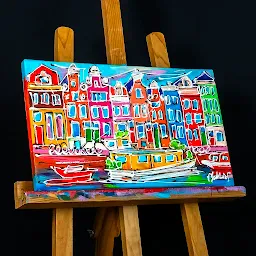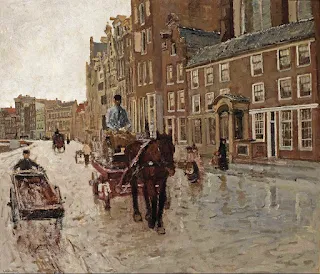Yesterday in Art History
🎂 Peter Wtewael (1596–1660)
Born on June 5, 1596, in Utrecht, Peter Wtewael was a Dutch Golden Age painter and the son of renowned Mannerist artist Joachim Wtewael. Though less prolific than his father, Peter carved his niche by specializing in genre scenes and mythological subjects, often infused with Caravaggesque influences. His works, such as "Kitchen Scene," showcase a blend of humor and sensuality, characteristic of the period's genre paintings.
Wtewael's relatively small oeuvre, comprising around five signed paintings and approximately twenty attributed works, reflects a brief but impactful career. His paintings are notable for their intricate compositions and vivid storytelling, contributing to the rich tapestry of Dutch Golden Age art.
🎂 Johan Thorn Prikker (1868–1932)
Johan Thorn Prikker, born on June 5, 1868, in The Hague, was a multifaceted Dutch artist whose work spanned painting, stained glass, mosaics, and design. Initially associated with Symbolism and Art Nouveau, Thorn Prikker later became a significant figure in German Expressionism after relocating to Germany in 1904.
His contributions to religious art, particularly his innovative stained-glass windows, marked a departure from traditional ecclesiastical designs. Thorn Prikker's integration of modernist aesthetics into sacred spaces exemplifies his role in bridging artistic movements and influencing subsequent generations of artists.
🎂 Pieter Geraedts (1911–1978)
Dutch painter Pieter Geraedts, born in 1911, was known for his figurative works and portraits. Active primarily in the mid-20th century, Geraedts's art captured the subtleties of human expression and form.
Though not widely known internationally, Geraedts's paintings have been featured in Dutch art circles and auctions, reflecting a consistent appreciation for his craftsmanship and contribution to Dutch visual arts.
🎂 Conrad Marca-Relli (1913–2000)
Born on June 5, 1913, in Boston, Conrad Marca-Relli was an American artist of Italian descent, associated with the Abstract Expressionist movement. He was a pioneer in the use of collage within large-scale compositions, often incorporating canvas and other materials to create dynamic, abstract forms.
Marca-Relli's innovative approach expanded the boundaries of painting and collage, influencing contemporaries and future artists. His works are held in major collections, including the Peggy Guggenheim Collection, underscoring his significance in modern art history.
🎂 Christy Brown (1932–1981)
Irish writer and painter Christy Brown was born on June 5, 1932, in Dublin. Despite being born with cerebral palsy, Brown overcame significant physical challenges to create literary and artistic works using his left foot. His autobiography, "My Left Foot," details his life story and was later adapted into an Academy Award-winning film.
Brown's paintings, often created with the same foot, exhibit a unique perspective shaped by his experiences. His determination and creativity continue to inspire discussions on disability, art, and human resilience.
🕯️ George Hendrik Breitner (1857–1923)
Dutch painter and photographer George Hendrik Breitner passed away on June 5, 1923. A leading figure in Amsterdam Impressionism, Breitner was renowned for his realistic depictions of urban life, capturing the dynamism of city streets and harbor scenes.
Breitner's integration of photography into his artistic process allowed him to study movement and light, enriching his paintings' authenticity. His works remain pivotal in understanding the evolution of modern urban representation in art.
George Hendrik Breitner - Rokin with the Nieuwezijdskapel, Amsterdam 1904
🕯️ Wim Schuhmacher (1894–1986)
Wim Schuhmacher, a Dutch painter born in Amsterdam, died on June 5, 1986. Known as "The Master of Grey," Schuhmacher's work is characterized by its subdued palette and magical realism. His paintings often evoke a sense of stillness and introspection.
Schuhmacher's contributions to Dutch art are significant, with his works featured in major museums. His unique style continues to influence artists exploring the interplay between realism and abstraction.
🕯️ Frederick Franck (1909–2006)
Dutch-American artist Frederick Franck passed away on June 5, 2006. A painter, sculptor, and author, Franck was deeply influenced by spirituality and humanism. His works often reflect themes of compassion and the human condition.
Franck's interdisciplinary approach bridged art and philosophy, with his sculptures and writings inviting contemplation and dialogue across cultures and beliefs.
🕯️ Friso Wiegersma (1925–2006)
Dutch lyricist and painter Friso Wiegersma died on June 5, 2006. Known for his contributions to Dutch music and visual arts, Wiegersma's creative endeavors spanned songwriting, painting, and stage design.
His multifaceted career enriched Dutch cultural life, with his artworks and lyrics reflecting a deep engagement with Dutch identity and aesthetics.
🕯️ Christopher Pratt (1935–2022)
Canadian painter Christopher Pratt passed away on June 5, 2022. Renowned for his precise and serene depictions of Newfoundland landscapes and architecture, Pratt's work embodies a meticulous attention to detail and composition.
Pratt's paintings, often characterized by their clarity and stillness, offer a contemplative view of Canadian life and have secured his place as a central figure in Canadian art history.
🕯️ Dick Vlottes (1932–2022)
Dutch comic artist Dick Vlottes died on June 5, 2022. Known for his work in the comic series "Kapitein Rob," Vlottes contributed significantly to Dutch popular culture through his illustrations and storytelling.
Vlottes's artistry in comics helped shape the visual language of Dutch graphic narratives, leaving a lasting legacy in the realm of illustrated literature.
Events
🏛️ The Beatles Perform in Blokker, Netherlands (1964)
On June 5, 1964, The Beatles performed their first of two concerts in Blokker, marking a significant moment in Dutch pop culture history.
🏛️ Opening of Musée Grévin in Paris (1882)
The Musée Grévin, a wax museum in Paris, opened its doors on June 5, 1882, offering the public lifelike representations of historical and contemporary figures.
Today in the Art World
Netherlands: Neo Rauch & Rosa Loy – Kleine Ewigkeit
Delden, Netherlands
In the picturesque town of Delden, the collaborative exhibition "Kleine Ewigkeit" showcased the works of German artists Neo Rauch and Rosa Loy. This joint presentation offered a unique dialogue between Rauch's surreal narratives and Loy's dreamlike compositions, inviting viewers into a world where reality and fantasy intertwine.
The exhibition highlighted the duo's exploration of timeless themes, blending figurative and abstract elements to challenge perceptions and evoke introspection. Set against the backdrop of Delden's historic architecture, "Kleine Ewigkeit" provided an immersive experience that resonated with both contemporary art enthusiasts and admirers of classical aesthetics.
SEE MORE
Greece: Marlene Dumas – Cycladic Blues
Museum of Cycladic Art, Athens
Athens welcomed the opening of "Cycladic Blues," a compelling exhibition by South African-born artist Marlene Dumas at the Museum of Cycladic Art. Running from June 5 to November 3, 2025, the show juxtaposed Dumas's expressive paintings with ancient Cycladic artifacts, creating a dialogue between contemporary emotion and ancient form.
Dumas's works, known for their raw portrayal of human vulnerability, found a profound resonance amidst the minimalist beauty of Cycladic sculptures. The exhibition invited visitors to reflect on themes of identity, mortality, and the timeless nature of human expression.
SEE MORE
United States: Joe Fig – Contemplating Vermeer
New Britain Museum of American Art, Connecticut
In Connecticut, the New Britain Museum of American Art unveiled "Contemplating Vermeer," an exhibition by contemporary artist Joe Fig. Inspired by the 2023 Vermeer exhibition at the Rijksmuseum, Fig's series of 17 new paintings captured museum-goers engaging with Vermeer's masterpieces, offering a meta-perspective on art appreciation.
Fig's meticulous attention to detail and thoughtful composition provided insight into the modern viewer's experience, bridging the gap between 17th-century Dutch art and contemporary observation. The exhibition, running through January 11, 2026, celebrated the enduring impact of Vermeer's work and the contemplative nature of art engagement.
SEE MORE
Stay tuned for tomorrow's edition of ART FLASH | Yesterday & Today
for more insights into the art world's past and present.


%201888.jpg)
%201888.jpg)
%201889.jpg)
%201891.jpg)

.jpg)
%201881.jpg)






.jpg)






